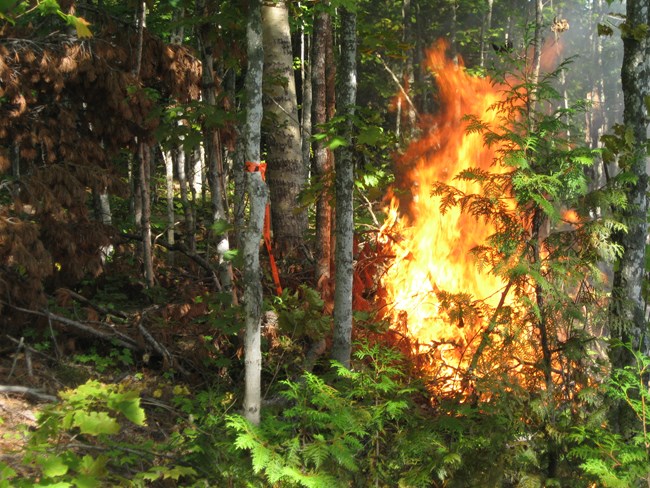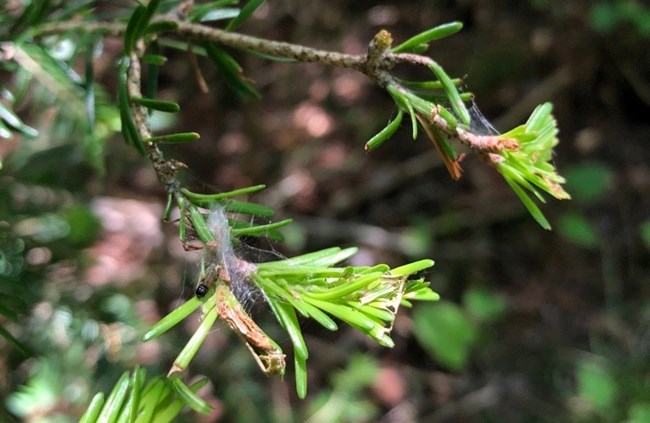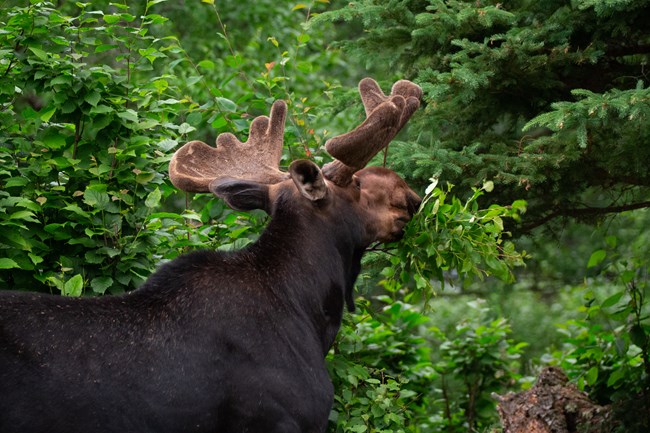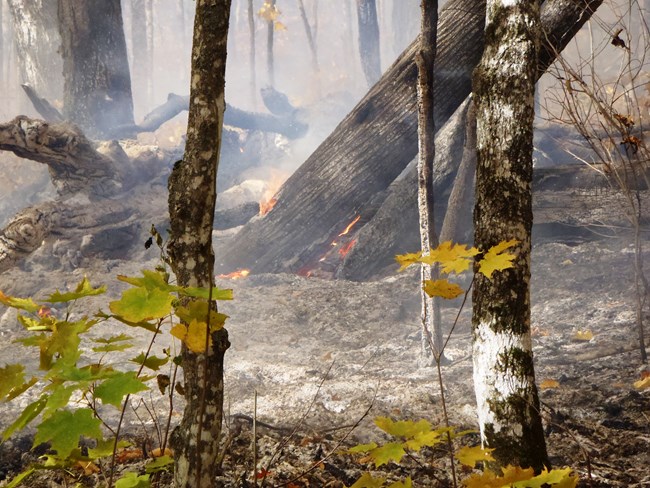Last updated: September 13, 2023
Article
Fire Ecology on Isle Royale

Bridget Byrne
Fire on Isle Royale
Fire is a significant environmental force. We often regard fire as an agent of destruction, but to nature, it can be an agent of necessary change. Fire's role in an ecosystem is known as fire ecology, and research can help us understand the relationships between fire, living things, and their environment, and the natural processes involved. On Isle Royale, certain species have adapted to depend on fire, while other species, and a number of unique factors, can naturally mitigate or intensify fire.
Fire and Vegetation
Isle Royale's biogeography influences fire ecology and behavior. There are two distinct forest biomes on the island - the temperate northern hardwoods of the southwest end, and the boreal stands of the northeast. Vegetation of the southwest end of the island is generally not as flammable as vegetation found in the northeast section of the island. Fuels found in the northeast section tend to be more fire prone. The northeastern fuels also are more fire dependent - meaning the species comomonly have traits that help them survive wildfire, or to use resources created by wildfire. Common fire dependent species on Isle Royale include bearberry, blueberry, fireweed, jack pine, and black spruce.

NPS
Trees
Trees commonly found on Isle Royale vary in flammability, from very low to very high. Some tree species have evolved natural fire adaptations, such as thick, protective bark. Other trees are more vulnerable to fire. Balsam fir, an extremely common species on the island, is considered very flammable. This is due to the tree's fire prone, dry needles, shallow root systems, thin, resinous bark, and dense understory of low-hanging dead branches.
On the other hand, some tree species on Isle Royale depend on fire for reproduction. One such species is jack pine. Jack pine have serotinous cones, meaning its cones can only open and disperse seeds once a certain temperature is reached, which can be achieved through direct sunlight or fire. Without either of these factors present, jack pine seeds cannot successfully propogate.
With semi-serotinous cones, black spruce is another fire dependent species. Black spruce is known as a "torching tree," meaning it is highly flammable. The dry, long limbs of a black spruce sweep the duff-covered forest floor, ready to ignite, burning upwards to the crown. However, black spruce tree density is relatively low on Isle Royale, and the species is most typically found in swampy areas, greatly reducing flammability except in cases of prolonged drought.
| Boreal Trees on Isle Royale | Flammability |
|---|

NPS
Forest Health
Spruce budworm is a native conifer pest impacting spruce and balsam fir trees. Spruce budworm populations are cyclical. On Isle Royale, time intervals for spruce budworm outbreaks are currently unknown, but research in the surrounding mainlands show cycles of 25-40 years. Spruce budworms feed on conifer tree branches, which defoliates the tree over time. Defoliation can result in damage or death of the impacted tree. As a result, trees effected by spruce budworm can contribute to increased fire risk, as well as intensified fire effects. Spruce budworm infestations were factors in the 2021 Horne Fire, 2022 Mount Franklin Fire, and the 1936 Fire.
Other pests impacting forest health on Isle Royale include spruce coneworm, large aspen tortrix, white satin moth, saddled prominent caterpillar, and bruce spanworm.

Uwe Konopka
Fire and Wildlife
Moose
Moose population on Isle Royale can greatly influence fire effects. Overbrowsing by a large moose population can create large scale vegetation change, which in turn can impact fire occurance.
An example of this is American yew. Isle Royale moose favor yew, making it a very overbrowsed species. Yew is also highly flammable, so the reduction of this species reduces the potential for a stand replacing crown fire. Yew is often succeeded by thimbleberry, which is not a favorite of moose, and not very flammable except in cases of prolonged drought.
Moose benefit from increased food production that can follow a fire. Species such as balsam fir and aspen are key in a moose's diet, and they are some of the first species that colonize new habitats created by a disturbance.

Valerie Martin
Environmental Factors
Climate. Isle Royale's climate is influenced by Lake Superior. Relative humidity normally recovers at night to high levels over most of the park, although ridge top humidity usually recovers less. This is due to marine inversion - lakeshore environments are cool and humid, and inland, higher elevation areas are warmer and drier. Marine inversion, and high humidity recovery, are less favorable fire conditions.
Weather. Wildfire on Isle Royale is most common during the hottest months of the year, July and August. Periods of drought and lightning storms make wildfire more likely.
Topography. Due to the lack of complex topography at Isle Royale, wildfires are mainly wind-driven. Slowly spreading surface fires with occasional torching are the norm with windspeeds below 15 mph.
Geography. Lake Superior, inland lakes, wet areas, and rock outcrops provide natural barriers to fire spread.
Soil. The mineral soils of Isle Royale are thin, often with thick layers of organic matter on the surface. Fire can creep in these layers, allowing the fire to appear extinguished, only to re-ignite when conditions are favorable.
